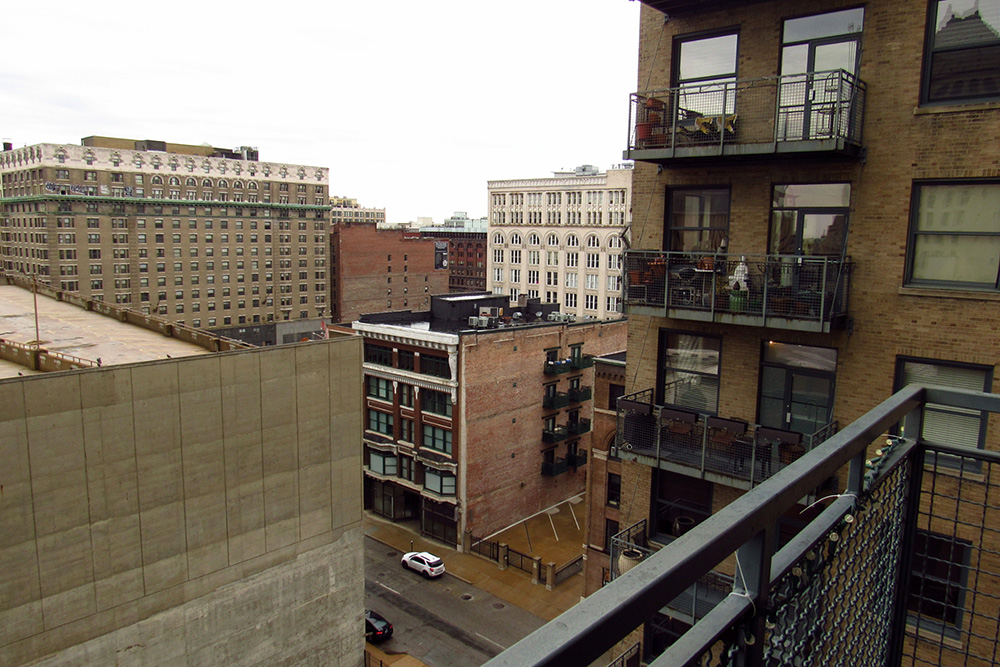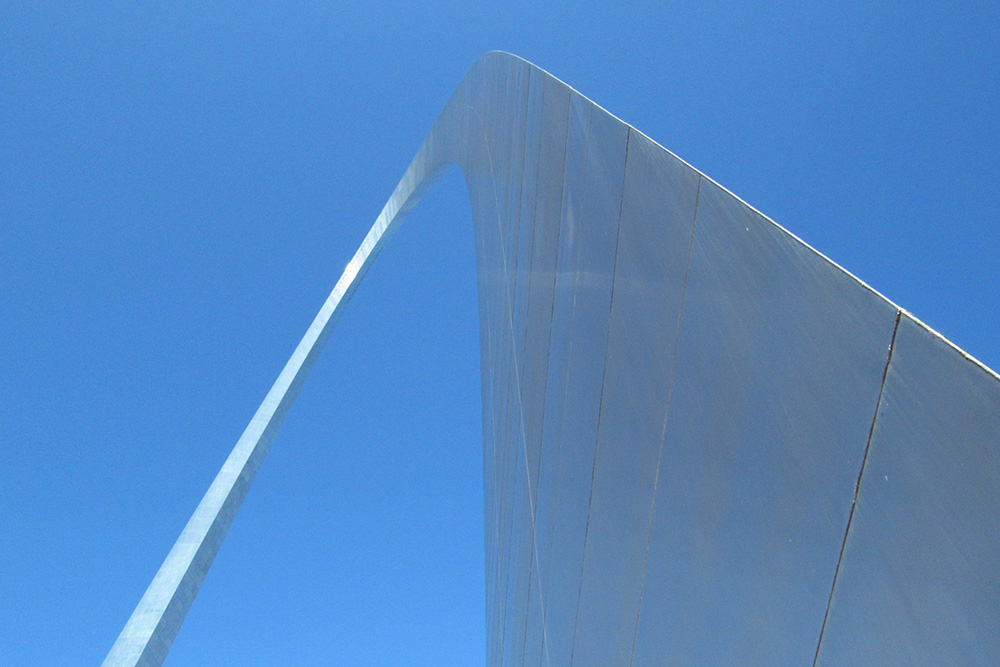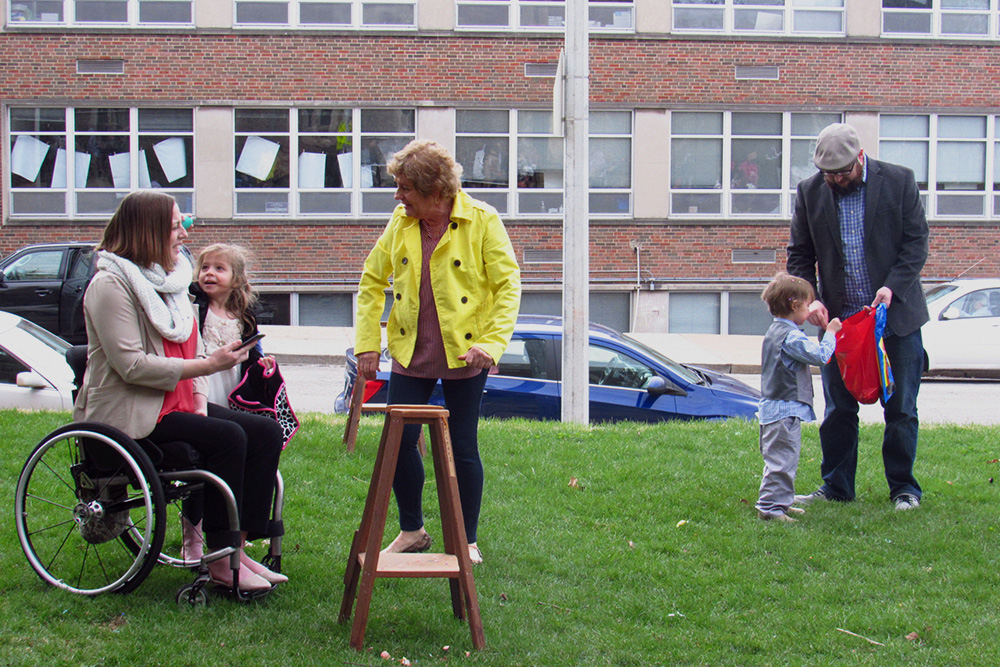Photos by Hoi Mun Yee
This story is part of a series. See the rest of them here.
Instead of learning about a city through a book, I decided to learn through a local.
High expectations for hosts after surfing in Ames
After experiencing a very enlightening and self-reflective experience couch-surfing in Ames, I had high hopes going into my trip to St. Louis. The more populated the area, the larger the pool of potential hosts with different interests and personalities. Roger Plackemeier’s profile reveals he is an architecture junkie who knows his city. I expected this to be either an intriguing trip into the history of the cityscape of St. Louis, or a boring lesson on architectural styles. I was hoping for the former.
His minimalist ninth floor loft in the heart of downtown St. Louis felt like an artist’s dream with paintings of chickens hanging on the wall and a balcony overlooking the city. I fell asleep at night on the leather couch staring at the air conditioning tubes, thinking all I wanted was my own loft. My biggest concern was the lack of doors to fully separate his quarters from mine. I could see Plackemeier giving me a negative review on the CouchSurfing app, citing that “surfer snored too loudly.”
Prior to my arrival, I had gotten in touch with one of Plackemeier’s former guests, Phillip Savic, from Toronto, to see what I would be getting into.
“What you gain from this is a unique, informal perspective about St. Louis in exchange for your own stories and experiences.”- Phillip Savic
“I think what made my stay with [Plackemeier] unique was the amount of knowledge he possessed about St. Louis and Missouri,” Savic says. “What you gain from this is a unique, informal perspective about St. Louis in exchange for your own stories and experiences.”
He was right. Upon my arrival, Plackemeier pointed me in the direction of everything he thought I needed to know, like the nearest metro station and the array of hat and textile factories in the neighborhood. My mind was running at full capacity trying to process the names of obscure buildings in St. Louis and the meaning behind the chicken paintings.
“There are a lot of cities that are missing some of that older architecture, but we still have that because we didn’t tear all our old buildings down.”- Roger Plackemeier

Getting in touch with architecture
I had nothing planned for this trip. I didn’t know anything about the city other than it’s home to the Gateway Arch and some baseball team called the Cardinals. I didn’t need to have a plan of my own. Plackemeier lived up to his profile description on CouchSurfing; he was a walking encyclopedia of St. Louis. His first order of business was to take me to the Arch. He told me me about the development of a new entrance and how the Arch is as tall as it is wide. He has lived in St. Louis longer than I have been alive, and as he admired his favorite piece of architecture in the city, there was no hiding his smile.
“St. Louis has a rich inventory of architecture, especially in downtown, because we have a mix of old buildings that are very architecturally significant and some of the not-so-much newer but mid-century art architecture,” Plackemeier says. “There are a lot of cities that are missing some of that older architecture, but we still have that because we didn’t tear all our old buildings down.”
I was the student and Plackemeier was the teacher. It felt like I was taking in more than I was offering. After all, I was the college student, and he was the semi-retired resident St. Louisan and owner of two lofts. In Ames, I was interacting with people my age in a basement made for gaming. Here, I was surrounded by professional magazines and in the presence of someone in his 50s. I wasn’t going to talk about memes with him. When not offering him stories from my experience growing up in Malaysia, I was eagerly awaiting what new information he had for me.

Plackemeier is a volunteer tour guide for St. Louis Architectural Walking Tours, taking tourists through downtown and telling the story of St. Louis through architecture. I joined him on a training tour as he learned a tour route he’d never led before from fellow volunteer, Beverly Hacker. A usual tour would cost $10 for participants.
“What we find through [tour] leaders is that most people are more interested in the stories of how the buildings fit into the culture and the history of the city, more so than we think,” Hacker says. “They’re interested in the stories of how the buildings relate to the city.”
“For a lot of us that are born here, if we didn’t travel it would never occur to us that not all cities look like this.”- Beverly Hacker
Interested, I was. After all, what made St. Louis different from other Midwest cities? If I hadn’t joined the tour I wouldn’t have known about the St. Louis brick industry, or learned about how many of the buildings used to be shoe factories. I would have walked past ornate buildings like the Arcade without knowing its history as a high-end shopping mall and how struggling artists can qualify for affordable units there. Many locals do not know the significance of these buildings, so tours usually consist of both St. Louisans and tourists.There were so many people out and about—so many families. People were congregating in the various downtown plazas. However, there were also many homeless men; I was filled with complicated feelings—a feeling of imbalance, resonating with the visible inequality I saw.
There was a red building that everybody in the training tour loved, but to me, it was just a brick building without context. It was the Wainwright building, once considered for demolition.
“I love the Wainwright building just because it is so significant in the history of architecture and tall building construction. It is considered one of the first skyscrapers,” Plackemeier says.
I wouldn’t have guessed that the building was ever considered a skyscraper. Hacker said not even all the locals knew this. My mind went back to all the cities I walked in. How many buildings did I walk past without learning their stories? How much do I actually know of the places that I’ve been to? This is the kind of intimate relationship I want to build with the cities I visit.
“For a lot of us that are born here, if we didn’t travel it would never occur to us that not all cities look like this,” Hacker says. “[Architecture] tells the stories, not just to the visitors, but to people who are from here.”
Painting images with knowledge
Plackemeier’s knowledge of his city goes beyond the downtown area. As he drove me around in his white Acura, he showed me where Chuck Berry used to perform in a tavern in University City. I glimpsed into St. Louis’s past looking at the huge courtyard outside the art museum and imagined how thousands of women gathered there to celebrate the ratification of women’s suffrage. Driving over the Delmar Divide was the first time I witnessed racial segregation in person instead of through a book or a documentary. I have seen these scenes on TV, but it never really hit me until I witnessed actual disparity in living conditions between white and black St. Louisans. What was striking was the proximity between these neighborhoods; they were literally separated by one street.
Negative or positive stories, Plackemeier’s enthusiasm for sharing his city is not something I had encountered in my prior couch-surfing experiences. Not only does he want surfers to go to these places he values, he enthusiastically asks for feedback. His favorite place to send visitors to is the City Museum. He likes hearing what people think of the place he describes as “creativity on steroids” and “imagination on crack.” I was sent there, and my delayed answer to his question would be that there were too many pre-teen couples that night.

As I took my eight-hour bus ride back to Des Moines, I couldn’t help but reflect on my initial and very unpopular opinion that American cities lack historical identities. I used to have this idea of generic American cities: just a conglomerate of tall, unattractive buildings next to a river. I can differentiate London from Paris based on images, but not Minneapolis from Chicago, even after going to both cities myself. The truth is, I have been too shallow to look past construction materials and take a glimpse into American history. Just because a building is not centuries old doesn’t mean it lacks a story.
Check out my other experience of couch-surfing in Ames here.

